DIRECTOR: Edward L. Cahn; PRODUCER: Carl Laemmle, Jr.; WRITERS: adaptation by John Huston and Tom Reed based on W. R. Burnett's novel, Saint Johnson; Cinematographer: Jackson Rose
CAST: Walter Huston, Harry Carey, Russell Hopton, Raymond Hatton, Ralph Ince, Harry Woods, Richard Alexander, Russell Simpson, Alphonse Ethier, Andy Devine, Hank Bell, Walter Brennan, Lois Wilson
THE REVIEWS.
"Exceptional Western that takes a familiar story...and reworks it with style but no flourishes...stark, realistic, with knockout finale." -- Leonard Maltin
"[I]t's a strikingly spare, bleakly downbeat film which hammers home its thesis -- that law and order involves a lot of killing...." Edward Buscombe, The BFI Companion to the Western
"The austere tone, the traditional O.K. Corral shootout notwithstanding, is all the more impressive considering the cheerful vacuity of most Westerns being made at the time. -- Phil Hardy, The Western
"There was a great deal of tension but little traditional physical action throughout the bulk of the film, which literally exploded in its last reel...." -- William K. Everson, A Pictorial History of the Western Film
"It's familiar now, but beautifully done, very tense, its atmosphere obviously indebted to William S. Hart....this may well be the definitive Wyatt Earp movie; at least it vies for the honor with MY DARLING CLEMENTINE -- Brian Garfield, Western Films: A Complete Guide
Those are rather impressive reviews of a 1932 western written by modern critics. But modern viewers might be puzzled by all that acclaim. It is a slow film with most of the story taking place in town and much of that indoors. At times it comes off clunky and stagey. But it was 1932.
William S. Hart and a few others had made westerns for adult audiences during the silent era, but the biggest star of that era was Tom Mix, whose fast-moving, action-filled films were geared to a younger audience. By 1932, Tom, now in his early fifties, was starring in his first sound series which, as it turned out, was his last. But his kind of western movie still predominated in the films of such notables as Hoot Gibson, Ken Maynard, Tim McCoy, and Buck Jones.
 |
| William S. Hart and "Fritz" |
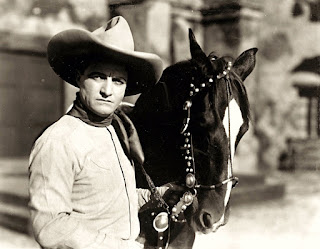 |
| Tom Mix and "Tony" |
But since William S. Hart never made the transition to sound, westerns produced for adult audiences were few and far between. That fact, as Buscombe notes, is an important reason why LAW AND ORDER is viewed so favorably.
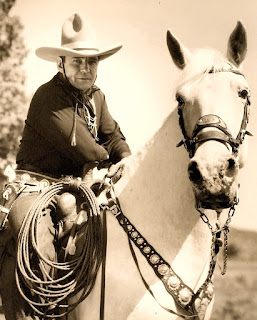 |
| Buck Jones and "Silver" |
Frame Johnson (Huston), along with his brother, Luther (Hopton) and two pals, Brandt (Carey) and Deadwood (Hatton), ride into Tombstone.
Frame is soon recognized as the famous lawman who cleaned up several Kansas cow towns. So spotless is his reputation that he has earned the nickname of "Saint" Johnson.
Tombstone is under the collective thumbs of the Northrup brothers (Ince, Alexander and Woods) who control everything in town and the surrounding area. In fact, just as Frame and his compadres arrive the Northrups are in the process of rigging the election of sheriff in order to give the office to one of their henchmen (Ethier).
Judge Williams (Simpson) and other citizens offer the job of town marshal to Frame. Since it is obvious that the town needs a strong law and order man in the office he reluctantly agrees to accept the job. This of course places him in direct conflict with the newly elected sheriff and his bosses, the Northrups. To assist him he deputizes his brother and their two friends.
At one point, Frame faces down a mob that is about to lynch simple-minded Johnny Kinsman (Devine) who accidentally killed a deputy sheriff. He argues that Johnny should be tried and if convicted he should hang legally rather than being lynched which was the standard procedure in Tombstone. In the subsequent trial Johnny was convicted and he did hang -- legally.
In his position as deputy marshal, Luther is forced to kill Kurt Northrup (Alexander) in self-defense. The remaining two brothers retaliate by ambushing and killing Brandt. This leads to the final shootout.
 |
| Luther, Deadwood, and Frame heading to a date with the Northrups |
It takes place in a dimly lit barn and only one person survives. The Northrups and their henchmen are killed, but so are Frame's brother, Luther, and their pal, Deadwood.
A distraught Frame rides out of town alone.
The screenplay was based on W.R. Burnett's novel, Saint Johnson. It was a thinly disguised fictional account of Wyatt Earp and Doc Holliday (Carey's Brandt is the Doc-like character) and the shootout at Tombstone's O.K. Corral. I almost wrote "the legendary" Wyatt Earp and "the famous shootout," but that would not have been true at the time Burnett's novel was published in 1930.
Earp did not enter the public consciousness outside the southwestern U.S. until Stuart Lake published Wyatt Earp, Frontier Marshal in 1931. Although it was a highly fictionalized biography it seemed to be authentic since the author had the co-operation of Wyatt who consented to being interviewed. As fate would have it, Wyatt never read the book since he died the year before its publication.
The book was a best seller that created the image of a western lawman who courageously put his life on the line almost daily in the pursuit of justice and the enforcement of law and order. Today the book will be found on the fiction shelf -- or if it isn't, it should be.
But the point is, Burnett enjoyed even more latitude in his book than Lake did precisely because his was a novel and he didn't even use the names of the Earps or Doc Holliday. And it is doubtful that very many viewers made the Earp connection when the film was originally released. Nevertheless, LAW AND ORDER is considered to be the first Wyatt Earp film.
THE ACTORS.
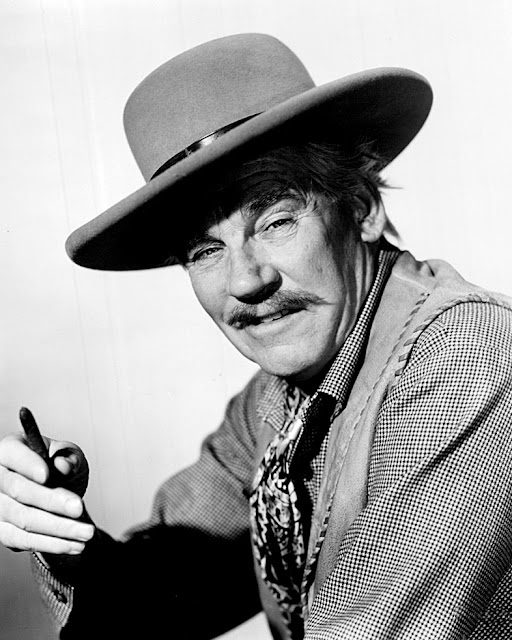 |
| A still from Walter Huston's last film, THE FURIES (1950) |
Walter Huston was born in Toronto in 1884. A stage actor, he broke into the movies in 1929 and in his second film he hit pay dirt as the villainous Trampas in THE VIRGINIAN (Paramount, 1929), directed by Victor Fleming and starring a young Gary Cooper in the title role.
After a great start with his first two Westerns, Huston appeared in a number of other Westerns down through the years, but they turned out to be hit-and-miss propositions.
He was the best thing in that over-hyped, over-budgeted, poorly acted train wreck, THE OUTLAW (RKO, 1943). The two young leads, Jane Russell and Jack Beutel (as Billy the Kid), were badly miscast and Thomas Mitchell, the consummate character actor, could do nothing with his poorly scripted role as a cowardly, afraid of his own shadow, Pat Garrett. And I don't know how Doc Holliday got into the Billy/Garrett story, but there he was in the form of Walter Huston. But he couldn't save the film.
Huston also appeared in DUEL IN THE SUN(Selznick, 1946), another overblown western epic, and though it is better amd much more watchable than THE OUTLAW, it will never be counted among the great western movies.
After being nominated for an Oscar three times (all non-westerns roles) and not winning, he finally succeeded when he was named the Best Supporting Actor for his outstanding performance in THE TREASURE OF THE SIERRA MADRE (WB, 1948). When discussion of this film comes up there is almost certain to be debate of whether or not it is a western. I prefer to believe that it is and that it is a great one aided in no small part by Huston's performance. Also contributing to the success of the film was its director, who just happened to be Huston's son, John, who won the the Oscar for Best Director for his work on the film.
In 1950, Huston appeared in THE FURIES (WB), directed by Anthony Mann. The film has its partisans but I don't fall into that camp. I tend to lump it in the overdone, over blown category with THE OUTLAW and DUEL IN THE SUN. Unfortunately, it was Huston's final film. He died shortly after its release.
Harry Carey (1878-1947) was born in New York City, but made his mark on the other coast. A real film pioneer he began appearing in movies as early as 1909.
He went on to become a star in silent Westerns that featured plots very much in the tradition of William S. Hart and far removed from those of Tom Mix. A young John Ford directed several of them.
With the advent of sound, Carey became a dependable and sought after character actor, who also starred in some gritty B-Westerns that owed more to Hart than Mix.
He was nominated for an Academy Award for Best Supporting Actor for MR. SMITH GOES TO WASHINGTON (Columbia, 1939), but lost out to Thomas Mitchell's portrayal of the drunken doctor in John Ford's STAGECOACH (UA, 1939).
One of his best, and most underrated, performances was in Howard Hawks' World War II drama, AIR FORCE (WB,1943). Despite his advanced age of sixty-five at the time, he was quite believable in his bittersweet, poignant role as the crew chief of a B-17 at the time of the attack on Pearl Harbor.
Like Huston, he was later cast in DUEL IN THE SUN and was responsible for one of that film's better performances.
Raymond Hatton (1887-1971) began acting in films at about the same time as Carey, and though he was never a star he sure was busy. He appeared in over a hundred silent films and then more than 200 films during the sound era. Over half of his roles in the sound era were in westerns. In most of those westerns, as in LAW AND ORDER, he filled the role of sidekick. He is best known as a popular "old-timer" sidekick who provided a comic touch in three B-Western movie series, but one who was more in the tradition of Gabby Hayes rather than Smiley Burnette. Burnette played the incompetent buffoon who was incapable of lending assistance to the hero unless it was by accident. Gabby could be funny, but he could also be counted on when the chips were down.
The same could be said of Hatton when he supported John Wayne and Ray Corrigan, and then Robert Livingston and Duncan Renaldo, in two of Republic's Three Mesquiteers combinations. He filled a similar role in Monogram's Rough Riders series that teamed him with Buck Jones and Tim McCoy. When the Rough Riders series ended as a result of Jones' tragic death in a nightclub fire, McCoy became Johnny Mack Brown's sidekick in Monogram's longest-running series.
He went on to become a star in silent Westerns that featured plots very much in the tradition of William S. Hart and far removed from those of Tom Mix. A young John Ford directed several of them.
With the advent of sound, Carey became a dependable and sought after character actor, who also starred in some gritty B-Westerns that owed more to Hart than Mix.
He was nominated for an Academy Award for Best Supporting Actor for MR. SMITH GOES TO WASHINGTON (Columbia, 1939), but lost out to Thomas Mitchell's portrayal of the drunken doctor in John Ford's STAGECOACH (UA, 1939).
One of his best, and most underrated, performances was in Howard Hawks' World War II drama, AIR FORCE (WB,1943). Despite his advanced age of sixty-five at the time, he was quite believable in his bittersweet, poignant role as the crew chief of a B-17 at the time of the attack on Pearl Harbor.
Like Huston, he was later cast in DUEL IN THE SUN and was responsible for one of that film's better performances.
Raymond Hatton (1887-1971) began acting in films at about the same time as Carey, and though he was never a star he sure was busy. He appeared in over a hundred silent films and then more than 200 films during the sound era. Over half of his roles in the sound era were in westerns. In most of those westerns, as in LAW AND ORDER, he filled the role of sidekick. He is best known as a popular "old-timer" sidekick who provided a comic touch in three B-Western movie series, but one who was more in the tradition of Gabby Hayes rather than Smiley Burnette. Burnette played the incompetent buffoon who was incapable of lending assistance to the hero unless it was by accident. Gabby could be funny, but he could also be counted on when the chips were down.
The same could be said of Hatton when he supported John Wayne and Ray Corrigan, and then Robert Livingston and Duncan Renaldo, in two of Republic's Three Mesquiteers combinations. He filled a similar role in Monogram's Rough Riders series that teamed him with Buck Jones and Tim McCoy. When the Rough Riders series ended as a result of Jones' tragic death in a nightclub fire, McCoy became Johnny Mack Brown's sidekick in Monogram's longest-running series.
 |
| Raymond Hatton, B-western sidekick extraordinaire |
Hatton continued to act right into the '60's, but with the demise of the B-western movie series, he was seen most often on TV.
THE DIRECTOR.
There isn't much to be said here about the career of Edward Cahn (1899-1963). William K. Everson stated it in blunt terms when he wrote that LAW AND ORDER, only the director's second film, "was also his artistic zenith; he never again made a film that was one-tenth as good."
But he did have a long career, but not in the western genre. In the mid-'50's, he began to specialize in the monster/horror films for which he is most remembered.
THE WRITER.
William Riley "W.R." Burnett (1899-1982) was born in Springfield, Ohio. He moved to Chicago when he was in his late twenties. At the time he had already written over a hundred short stories and five novels -- all unpublished.
He took a job as a night clerk in a run-down hotel in a bad section of the city. There he became acquainted with the criminal underworld that inspired his first published novel, Little Caesar (1929), which was made into a movie two years later that gave Edward G. Robinson the role that made him a star.
From that point on Burnett was a successful and busy novelist who also wrote and adapted stories for film. He was best known for his crime novels. One of them, High Sierra, was turned into a popular Warner Brothers movie in 1941 that starred Humphrey Bogart and was directed by Raoul Walsh. Eight years later, the studio re-made the film, but as a classic Western, COLORADO TERRITORY, again directed by Walsh, and starring Joel McCrea and Virginia Mayo.
He also wrote the story for another outstanding western, YELLOW SKY (Fox,1948), directed by William Wellman and starring Gregory Peck, Anne Baxter, and Richard Widmark.
Universal got good mileage out of LAW AND ORDER. They subsequently re-made it three times:
WILD WEST DAYS (1937): a B-western serial starring Johnny Mack Brown
LAW AND ORDER (1940): a B-western feature starring Johnny Mack Brown
LAW AND ORDER (1953): a B+-western starring Ronald Reagan and Dorothy Malone
THE DIRECTOR.
There isn't much to be said here about the career of Edward Cahn (1899-1963). William K. Everson stated it in blunt terms when he wrote that LAW AND ORDER, only the director's second film, "was also his artistic zenith; he never again made a film that was one-tenth as good."
But he did have a long career, but not in the western genre. In the mid-'50's, he began to specialize in the monster/horror films for which he is most remembered.
THE WRITER.
William Riley "W.R." Burnett (1899-1982) was born in Springfield, Ohio. He moved to Chicago when he was in his late twenties. At the time he had already written over a hundred short stories and five novels -- all unpublished.
He took a job as a night clerk in a run-down hotel in a bad section of the city. There he became acquainted with the criminal underworld that inspired his first published novel, Little Caesar (1929), which was made into a movie two years later that gave Edward G. Robinson the role that made him a star.
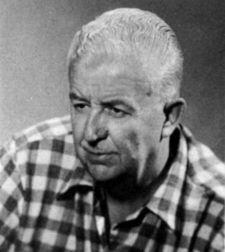 |
| W.R. Burnett |
He also wrote the story for another outstanding western, YELLOW SKY (Fox,1948), directed by William Wellman and starring Gregory Peck, Anne Baxter, and Richard Widmark.
Universal got good mileage out of LAW AND ORDER. They subsequently re-made it three times:
WILD WEST DAYS (1937): a B-western serial starring Johnny Mack Brown
LAW AND ORDER (1940): a B-western feature starring Johnny Mack Brown
LAW AND ORDER (1953): a B+-western starring Ronald Reagan and Dorothy Malone
 |
| Ronald Reagan is Frame "Saint" Johnson |

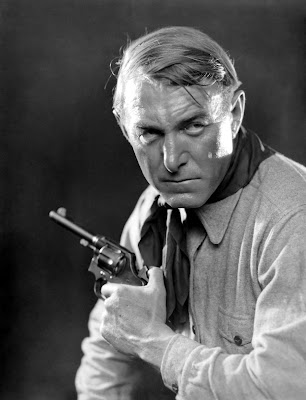
No comments:
Post a Comment